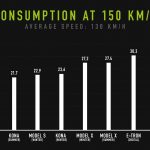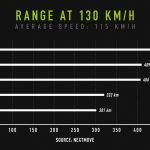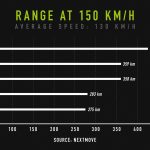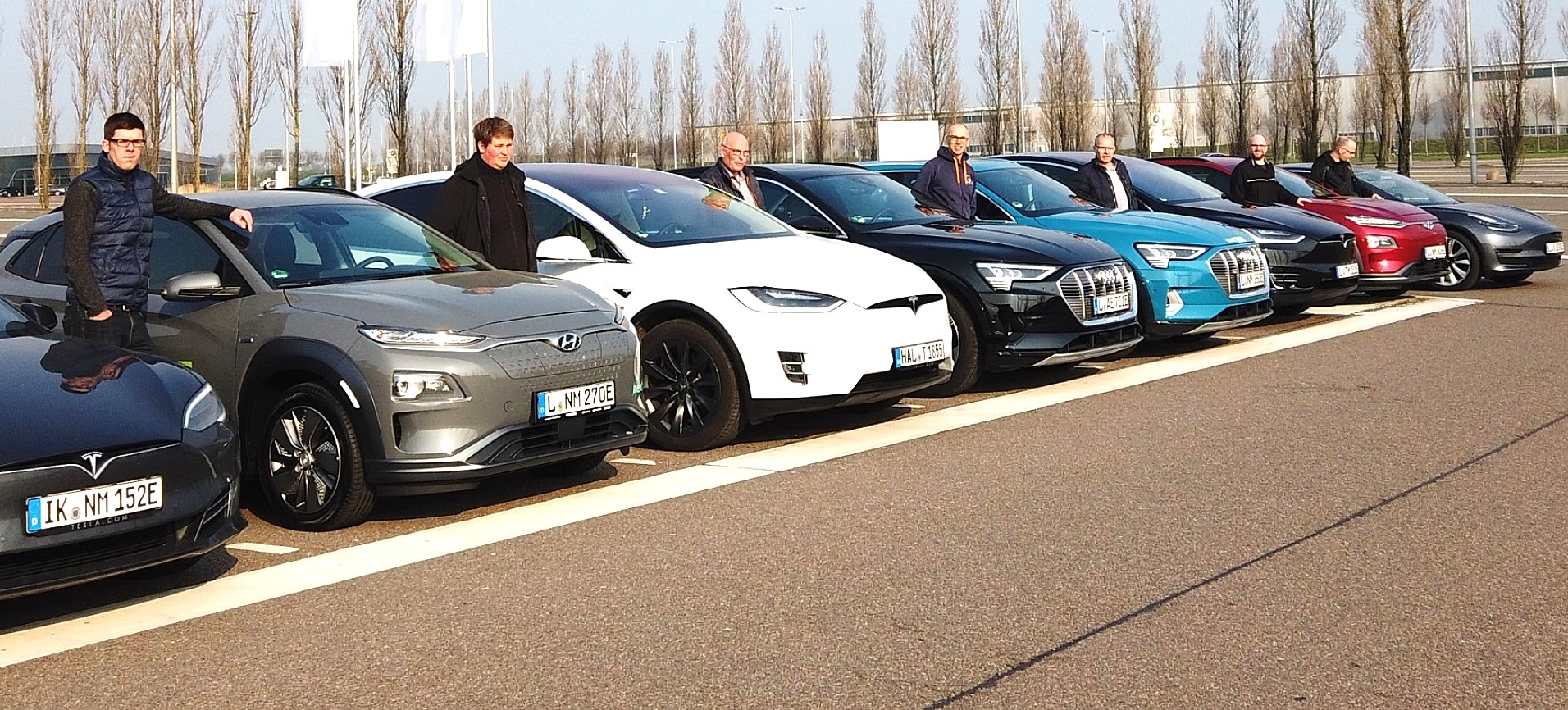
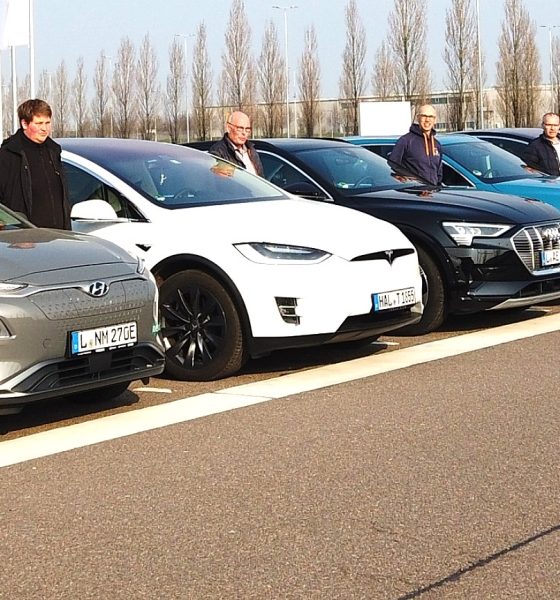
News
Tesla Model S, 3, X takes on Audi e-tron in Autobahn range and efficiency test
German electric vehicle rental company nextmove recently conducted what could only be described as the ultimate Autobahn efficiency and range test, pitting the Tesla Model S, 3, and X against the upstart Audi e-tron and the bang-for-your-buck Hyundai Kona Electric. Following the EV rental firm’s test, it was evident that veteran automakers such as Audi still have a long way to go before they catch up to Tesla’s experience in electric cars.
Eight vehicles were used for nextmove’s test: a Model S 100D (equipped with 19” winter tires), two Tesla Model X 100D (one fitted with 19” winter tires and the other fitted with 20” summer tires), one Tesla Model 3 Dual Motor AWD (equipped with 19” summer tires), two Audi e-tron (one with digital side mirrors and another with classic mirrors; both equipped with 21” summer tires), and two Hyundai Kona Electric (one fitted with 17” summer tires and the other fitted with 17” winter tires). Each vehicle’s tire pressure was set according to manufacturer specifications, and each was driven by an experienced electric car driver.

Several rules were observed to keep the Autobahn test as controlled as possible. Cruise control was only utilized once the target cruising speed of 130 kph (81 mph) and 150 kph (93 mph) was reached. Features such as Regenerative Braking were also avoided, and heating was largely disabled. Thet route was 85 km (52.8 miles) long, with the vehicles traveling 130 kph one way and 150 kph in the other.
The results of both the 130 kph (81 mph) and 150 kph (93 mph) tests revealed that the Tesla Model 3 was the most efficient vehicle among the eight that the EV rental company evaluated. Following the Model 3 was the Hyundai Kona Electric in summer tires, which is, in turn, followed by the Tesla Model S 100D. The largest vehicle in the group, the Tesla Model X, proved less efficient than the Model 3, Model S, and Kona Electric, but it proved notably more efficient than the Audi e-tron.
- (Photo: nextmove.de)
- (Photo: nextmove.de)
The Audi e-tron and the Tesla Model X had already gone head-to-head in a nextmove test in the past. During the previous test, the EV rental company utilized a pre-production version of the Audi e-tron, and it proved to be the electric equivalent of a gas-guzzler, being 23% less efficient than the larger, heavier Tesla Model X.
While the Audi e-tron performed much better against the Tesla Model X than its pre-production counterpart in the recent test, the all-electric SUV still proved less efficient than the Silicon Valley-made crossover. Quite interestingly, the difference in energy consumption between the Tesla Model X and Audi e-tron was more prominent at lower speeds than at higher speeds.

Tesla’s Model S, 3, and X cleared the house in terms of range. During the 130 kph test, the Model S 100D showed a range of 480 km (298 miles), the Model X 100D showed a range of 409 km (254 miles), and the Model 3 managed a range of 406 km (252 miles). The Hyundai Kona Electric turned in a respectable 322 km (200 miles), and the Audi e-tron, in last place, managed 301 km (187 miles).
The results of the 150 kph test were quite similar. The Model S, X and 3 proved superior once more with a range of 428 km (265 miles), 359 km (223 miles), and 358 km (222 miles). The Hyundai Kona Electric managed 283 km (176 miles), while the Audi e-tron achieved a range of 275 km (171 miles). With these results in mind, it appears that veteran automakers such as Audi still have their work cut out for them in terms of designing electric vehicles that offer a balance of power, efficiency, and range.
- (Photo: nextmove.de)
- (Photo: nextmove.de)
It should be noted that the Tesla Model X utilized by nextmove in its Autobahn efficiency test was a 100D unit, and thus, the vehicle was not yet equipped with the company’s updated high-efficiency drive units. With a “Raven” Model S and Model X in the equation, the German EV rental company’s test could very well have ended in a far more lopsided manner.
The full results of nextmove‘s eight-way comparative test could be accessed here.
Watch nextmove’s Autobahn efficiency test in the video below. English subtitles are available.

Elon Musk
Elon Musk’s X will start using a Tesla-like software update strategy
The initiative seems designed to accelerate updates to the social media platform, while maintaining maximum transparency.

Elon Musk’s social media platform X will adopt a Tesla-esque approach to software updates for its algorithm.
The initiative seems designed to accelerate updates to the social media platform, while maintaining maximum transparency.
X’s updates to its updates
As per Musk in a post on X, the social media company will be making a new algorithm to determine what organic and advertising posts are recommended to users. These updates would then be repeated every four weeks.
“We will make the new 𝕏 algorithm, including all code used to determine what organic and advertising posts are recommended to users, open source in 7 days. This will be repeated every 4 weeks, with comprehensive developer notes, to help you understand what changed,” Musk wrote in his post.
The initiative somewhat mirrors Tesla’s over-the-air update model, where vehicle software is regularly refined and pushed to users with detailed release notes. This should allow users to better understand the details of X’s every update and foster a healthy feedback loop for the social media platform.
xAI and X
X, formerly Twitter, has been acquired by Elon Musk’s artificial intelligence startup, xAI last year. Since then, xAI has seen a rapid rise in valuation. Following the company’s the company’s upsized $20 billion Series E funding round, estimates now suggest that xAI is worth tens about $230 to $235 billion. That’s several times larger than Tesla when Elon Musk received his controversial 2018 CEO Performance Award.
As per xAI, the Series E funding round attracted a diverse group of investors, including Valor Equity Partners, Stepstone Group, Fidelity Management & Research Company, Qatar Investment Authority, MGX, and Baron Capital Group, among others. Strategic partners NVIDIA and Cisco Investments also continued support for building the world’s largest GPU clusters.
News
Tesla FSD Supervised wins MotorTrend’s Best Driver Assistance Award
The decision marks a notable reversal for the publication from prior years, with judges citing major real-world improvements that pushed Tesla’s latest FSD software ahead of every competing ADAS system.

Tesla’s Full Self-Driving (Supervised) system has been named the best driver-assistance technology on the market, earning top honors at the 2026 MotorTrend Best Tech Awards.
The decision marks a notable reversal for the publication from prior years, with judges citing major real-world improvements that pushed Tesla’s latest FSD software ahead of every competing ADAS system. And it wasn’t even close.
MotorTrend reverses course
MotorTrend awarded Tesla FSD (Supervised) its 2026 Best Tech Driver Assistance title after extensive testing of the latest v14 software. The publication acknowledged that it had previously criticized earlier versions of FSD for erratic behavior and near-miss incidents, ultimately favoring rivals such as GM’s Super Cruise in earlier evaluations.
According to MotorTrend, the newest iteration of FSD resolved many of those shortcomings. Testers said v14 showed far smoother behavior in complex urban scenarios, including unprotected left turns, traffic circles, emergency vehicles, and dense city streets. While the system still requires constant driver supervision, judges concluded that no other advanced driver-assistance system currently matches its breadth of capability.
Unlike rival systems that rely on combinations of cameras, radar, lidar, and mapped highways, Tesla’s FSD operates using a camera-only approach and is capable of driving on city streets, rural roads, and freeways. MotorTrend stated that pure utility, the ability to handle nearly all road types, ultimately separated FSD from competitors like Ford BlueCruise, GM Super Cruise, and BMW’s Highway Assistant.
High cost and high capability
MotorTrend also addressed FSD’s pricing, which remains significantly higher than rival systems. Tesla currently charges $8,000 for a one-time purchase or $99 per month for a subscription, compared with far lower upfront and subscription costs from other automakers. The publication noted that the premium is justified given FSD’s unmatched scope and continuous software evolution.
Safety remained a central focus of the evaluation. While testers reported collision-free operation over thousands of miles, they noted ongoing concerns around FSD’s configurable driving modes, including options that allow aggressive driving and speeds beyond posted limits. MotorTrend emphasized that, like all Level 2 systems, FSD still depends on a fully attentive human driver at all times.
Despite those caveats, the publication concluded that Tesla’s rapid software progress fundamentally reshaped the competitive landscape. For drivers seeking the most capable hands-on driver-assistance system available today, MotorTrend concluded Tesla FSD (Supervised) now stands alone at the top.
News
Elon Musk’s Grokipedia surges to 5.6M articles, almost 79% of English Wikipedia
The explosive growth marks a major milestone for the AI-powered online encyclopedia, which was launched by Elon Musk’s xAI just months ago.

Elon Musk’s Grokipedia has grown to an impressive 5,615,201 articles as of today, closing in on 79% of the English Wikipedia’s current total of 7,119,376 articles.
The explosive growth marks a major milestone for the AI-powered online encyclopedia, which was launched by Elon Musk’s xAI just months ago. Needless to say, it would only be a matter of time before Grokipedia exceeds English Wikipedia in sheer volume.
Grokipedia’s rapid growth
xAI’s vision for Grokipedia emphasizes neutrality, while Grok’s reasoning capabilities allow for fast drafting and fact-checking. When Elon Musk announced the initiative in late September 2025, he noted that Grokipedia would be an improvement to Wikipedia because it would be designed to avoid bias.
At the time, Musk noted that Grokipedia “is a necessary step towards the xAI goal of understanding the Universe.”
Grokipedia was launched in late October, and while xAI was careful to list it only as Version 0.1 at the time, the online encyclopedia immediately earned praise. Wikipedia co-founder Larry Sanger highlighted the project’s innovative approach, noting how it leverages AI to fill knowledge gaps and enable rapid updates. Netizens also observed how Grokipedia tends to present articles in a more objective manner compared to Wikipedia, which is edited by humans.
Elon Musk’s ambitious plans
With 5,615,201 total articles, Grokipedia has now grown to almost 79% of English Wikipedia’s article base. This is incredibly quick, though Grokipedia remains text-only for now. xAI, for its part, has now updated the online encyclopedia’s iteration to v0.2.
Elon Musk has shared bold ideas for Grokipedia, including sending a record of the entire knowledge base to space as part of xAI’s mission to preserve and expand human understanding. At some point, Musk stated that Grokipedia will be renamed to Encyclopedia Galactica, and it will be sent to the cosmos.
“When Grokipedia is good enough (long way to go), we will change the name to Encyclopedia Galactica. It will be an open source distillation of all knowledge, including audio, images and video. Join xAI to help build the sci-fi version of the Library of Alexandria!” Musk wrote, adding in a later post that “Copies will be etched in stone and sent to the Moon, Mars and beyond. This time, it will not be lost.”

